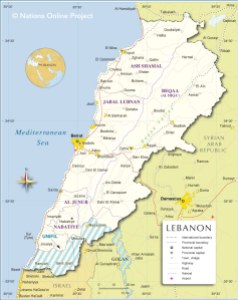For general information about the country profiles click here.
 Population: 4,424,888
Population: 4,424,888
HDI ranking: 72/187
HDI score: 0.745
The idea of decentralization was introduced in the 1989 Taif Accord, but it was not until 2014 that a bill for decentralization was drafted.
Local governance at a glance
- Lebanon is divided into six governorates which are subdivided into districts, towns and villages. Municipalities, administrative units below the district level, are the only form of administrative decentralization (UCLG, 2009).
- Municipal councils, elected by the municipality, elect their mayor. Villages and towns which are not a municipality elect a mukhtar (headman) and council of elders (UCLG 2009; Encyclopedia Britannica, 2014)
- The Ministry of Interior and Municipalities is responsible for municipalities and villages that are not part of any municipalities (UCLG, 2009).
- There are no legislative quotas for women at the subnational level (Quota Project, 2009).
Civil society actors
- The Lebanese Center for Policy Studies (LCPS) promotes transparency and accountable governance through advocacy, research and trainings. It focuses most specifically on judicial reforms, transparent budget processes, and decentralization and local governance (LCPS, 2014).
- The Lebanese Foundation for Permanent Civil Peace (LFCPC) encourages civic participation and stronger local government by working to increase the capacity of Lebanon’s municipalities (LFCPC, 2005).
- Development for People and Nature Association (DPNA) promotes “justice, solidarity, human rights and environmental protection” and works “to respond to the needs of local communities on the basis of sustainable development” and “to appreciate and increase local communities capacities and values” (DPNA, 2014).
Capacity building institutions
- Building Alliance for Local Advancement, Development, and Investment (BALADI) is a USAID program that encourages “municipalities (in cooperation with local Non-Governmental Organizations, civil society organizations, and members in the community) to annually submit well-prepared and well-designed community projects for possible funding” (USAID, 2014).
Fiscal control
- Municipalities can only collect taxes on “rental rates, building permits, pipe maintenance, the use of municipal public land, advertisements in cinemas, cattle slaughtering, meeting rooms and certain types of businesses.” These directly collected taxes make up 30% of the municipal budget (UCLG, 2009).
- According to the 1979 Law on Municipalities, the central government should collect certain taxes on behalf of municipalities and transfer some directly back to them and to the Independent Municipal Fund (IMF). The central government began making the transfers to the IMF only after 1997 (UCLG, 2009).
Key initiatives for participatory local governance
- The 1989 Taif Accord, which ended the civil war, introduced the idea of decentralization. However, it was not until 2014 that a bill on decentralization was drafted (CIPE, 2014).
- In 1998, municipal elections were reinstated, leading to new impulse towards decentralization (LCPS, 2012).
- The formation of municipal unions across the country resulted in an emergence of important actors in support of the process toward decentralization (LCPS, 2012).
- In April 2014, the first bill to increase administrative decentralization was unveiled. It aimed to devolve more power and rights, including more financial autonomy and accountability for municipalities. The areas of infrastructure, health and transportation remain under control of the central government (Zawya, 2014).
Challenges for participatory local governance
- “[I]n a society like Lebanon’s with entrenched traditions of patronage, the danger is that decentralization simply shifts rather than eradicates the locus of corruption” (O’Sullivan, 2014).
- Sufficient administrative capacity for municipalities must be granted in order to enable them to cope with new tasks and responsibilities for more decentralization (O’Sullivan, 2014).
- Due to an implementation gap, the “IMF system lacks transparency, thus breeding corruption and unfair distribution of resources. As a result, local municipalities often do not receive the full amounts allocated to them in the budget” (CIPE, 2014).
______________________
List of sources:
Center for International Private Enterprise (CIPE), 2014, Nakagaki, M.: “Can Decentralization Solve Political Gridlock in Lebanon?”
Development for People and Nature Association (DPNA), 2014: http://www.dpna-lb.org/.
Encyclopedia Britannica, 2014: “Lebanon. Local Government.”
Lebanese Center for Policy Studies (LCPS), 2012, Atallah, S., 2012: “Decentralization in Lebanon.”
Lebanese Center for Policy Studies (LCPS), 2014: http://www.lcps-lebanon.org/about.php.
Lebanese Foundation for Permanent Civil Peace (LFCPC), 2005: http://www.kleudge.com/flpcp/projets_en.asp.
O’Sullivan, D., 2014, Executive Magazine: “Decentralization – the best way to tackle corruption?”
Quota Project, 2009: “Lebanon.”
United Cities and Local Governments (UCLG), 2009: “UCLG Country Profiles: Lebanese Republic.”
USAID, 2014: http://baladi-lebanon.org/.
Zawya, 2014: “Sleiman launches long-awaited bill to decentralize government.”
